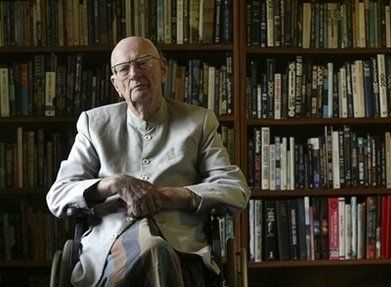
I didn't know about the concept of abundance or exponential thinking as I embarked on my career in the '70s. I was just looking for something that would capture my attention and passion. Something beyond a job or even a career. Oh yes, I needed a job because I needed to find a way to "pay the rent" and other basic needs. But the job was just a path to passion.
I found my beacon of light in scientist and science fiction author Arthur C. Clarke, who invented geosynchronous orbiting satellites just after the Second World War. He saw them come to fruition in 1965, when the first ones were launched. When I heard Clarke lecture on "the power of geosynchronous satellites" shortly thereafter, I found the idea that captivated me and would never let me go. It was global communications delivered via satellite with only three satellites that appeared to be "stationary" above the earth at 22,300 miles in space. These three "geosynchronous-orbiting satellites" could communicate with any location on Earth.
It was the time of the Cold War. We didn't know much about what was behind the Berlin wall or the Great Wall of China. I became obsessed with the idea of instant global communications, and went on to write my Master's Thesis on the impact these satellites would have on communications, governments and cultures. Esoteric and far-fetched then? Definitely. The vision materialized for me when I was fortunate to work in the industries that were needed to pull these factors together -- satellites, television and cable. They were all critical to launch the first basic cable network delivered nationally via satellite and cable in 1977 -- Madison Square Garden Sports, which later became USA Network.
Today, of course, we have instant communications any way and anywhere we want them. We can travel the earth, and send messages, voice and video from every city on every continent, from deltas in remote Congo, from the streets of Bangladesh, the Straits of Magellan and even from the top of Mt. Everest.
And so it is with everything that results from exponential thinking -- which refers to exponential growth. It's a simple formula. 1 becomes 2, 2 becomes 4, 4 becomes 8 and so on. It's explained in the book ABUNDANCE: The Future is Better Than You Think, written by space entrepreneur Peter H Diamandis and award-winning science writer, Steven Kotler. It's this exponential thinking, perhaps best understood in the semiconductor world by Moore's Law. Gordon Moore observed an article written in 1965, that the number of integrated circuit components on a computer chip doubled every year. This exponential growth has moved circuitry from massive full room mainframe computers to smart phones in a mere few decades.
So it is today that a group of fearless scientists and business executives are the motivation behind Singularity University, which teaches the process of exponential thinking to solve some of the most pressing human challenges of the coming decades. I am sure the much of what they are working on, as far out in space as it might seem to some, will come to pass and be as normal as instant communications are to us today.
One of its members, Dean Kamen, perhaps best known for inventing the Segway, has hundreds of patents to his name. One is for the Slingshot, a water purification plant in a box the size of an under the counter refrigerator, and can produce pure drinking water for one cent per liter. It's a promising development for the 1.1 billion who don't have safe drinking water today.
Today, 3D manufacturing is producing prosthetic legs made to order for the individual. By simply photographing the "good leg" and forwarding these photos from a smart phone to a 3D manufacturing company, the made to order prosthesis can be delivered to even remote locations in 3 weeks for $3,000. This compares with off the shelf prosthetics costing on average $60,000 today. Just think what 3D manufacturing will produce in years to come. Manufacturing replacement human organs is not that far in the future. People waiting for kidney transplants would need to wait no longer.
Just imagine a world ripe with abundance and the seemingly unlimited advances coming to fruition in our lifetime.
Arthur C. Clarke inspired me to envision a world fully connected. Peter Diamandis inspires me to understand a world ripe with abundance, and to imagine wondrous improvements for mankind.